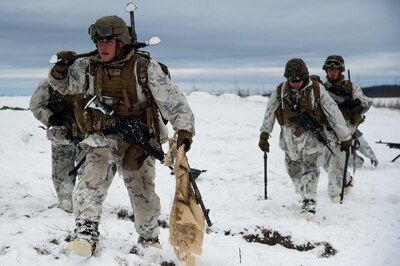By Air Force Airman Michael S. Murphy 11th Wing
JOINT BASE ANDREWS, Md., March 20, 2018 — Robyn Kramer
listened to the dull and tiresome beep from a heart monitor in a dark hospital
room in the Southeast Alabama Medical Center in Dothan, Alabama, March 12,
2014. Light cut into the room as the door opened and a doctor walked in, waking
her and her husband, Kyle Kramer.
The doctor informed them their newborn son, Jack, was in
worse shape than they’d thought.
“The doctor had tears in her eyes, and that’s when she told
us that she had a bad feeling about [his heart],” Robyn said.
That night, the doctor called in an echo cardiogram
technician to perform a scan that revealed Jack had hypoplastic left heart
syndrome, a congenital condition causing the heart to improperly pump blood to
the body. Their son was going to need at least three open heart surgeries.
“I remember asking her straight up, ‘Is he going to die?’”
Robyn said. “She just had the saddest look on her face, and she said she didn’t
know. That was a question from then on that I constantly asked the doctors, and
always got the same sad face.”
Fighting for Life
From that day on, she and her husband, an Air Force captain
and now a pilot with the 1st Helicopter Squadron here, found themselves
fighting a battle to fix their baby boy’s malformed heart. And to make it more
difficult, the diagnosis came as a surprise.
“I had all of the proper prenatal care,” Robyn said. “There
is no history of heart disease in our family. The second he came out, the
doctor hadn’t even cut the cord yet, and he said, ‘Something is wrong with
him.’”
The nurses and doctors originally told them the problem was
baby Jack’s lungs. He was taken to the neonatal intensive care unit at the SAMC
and was projected to return to his family about 12 hours later. Kyle and Robyn
felt there was no need to worry.
After additional testing, the hospital decided to send Jack
to the Children’s of Alabama hospital in Birmingham.
“They ended up flying Jack out [to Birmingham] because they
couldn’t take care of him,” Robyn explained. “We went down to see Jack one last
time and the flight nurse was putting him onto a stretcher. The flight nurse
told Kyle to kiss him goodbye, and I started crying.”
In the coming months, Jack would receive multiple heart
surgeries, beginning at Children’s of Alabama hospital and ending at Boston
Children’s Hospital in Boston.
By the time Jack was 2, he had received medical operations
costing more than $2 million dollars.
Support Builds Resilience
Kyle, who had been an Air Force combat controller, said his
previous military experience helped him tackle the issues his family was
facing.
“You can sit and wallow in self-pity or you can pick
yourself up and continue on,” he said. “We did everything that we could. We
brought him to the hospital as the best option that we had at the moment, and
there was nothing else but to have faith that he would come out fine. That kind
of kept me going, and I never worried about him dying.”
The Kramers didn’t have to go through it alone. Kyle and
Robyn both said they received overwhelming support from his leadership and unit
and remained resilient and hopeful in the face of Jack’s rare heart condition.
Anytime Jack was in the hospital, Kyle was released to go take care of him.
“I know that, no matter what happens, that his work lets him
go, whenever it may be,” Robyn said. “I don’t know if there would be any other
job that would be so cool with it. It’s so funny, because Kyle was two weeks
from separating years ago, and he got picked up to be a pilot. If we had any
other job, things would be so different.”
And it wasn’t just colleagues and leaders. Kyle said the
kindness received from others made an unforeseen impact in his life.
“I will forever be in their debt,” he said. “That has been
the most humbling thing I have come across. It’s when they say, ‘Go take care
of your kid’ and that’s it. I don’t even know how to say thank you.”
Recovery
Robyn said Jack has far exceeded the medical standard set by
doctors for children with HLHS for intellectual development and physical
growth.
“He just got cleared a month ago for the first time ever,”
Robyn added. “He doesn’t have to go back to the cardiologist for one year, and
before that it was every three months.”
The Kramers have taken up the task of making others aware of
the rare heart defect by maintaining a social media presence about Jack and his
heart defect.
“They appropriately went all-in,” said Air Force Maj. Katy
Tenpenny, a helicopter pilot instructor at Fort Rucker, Alabama, while Kyle was
there, and now the Air Force District of Washington chief of helicopter
operations here. “First is understanding and taking care of him, so I think
that was their immediate thought, but I think they are also trying to raise
awareness.”
With his health now better than ever, the Kramers have high
hopes for Jack’s future and what he will accomplish.
“He is going to go to Harvard,” Kyle said with a grin.
“Harvard is the medical school for Boston Children’s Hospital, so all his
doctors are from Harvard. We always joke that he is going to end up back
there.”









